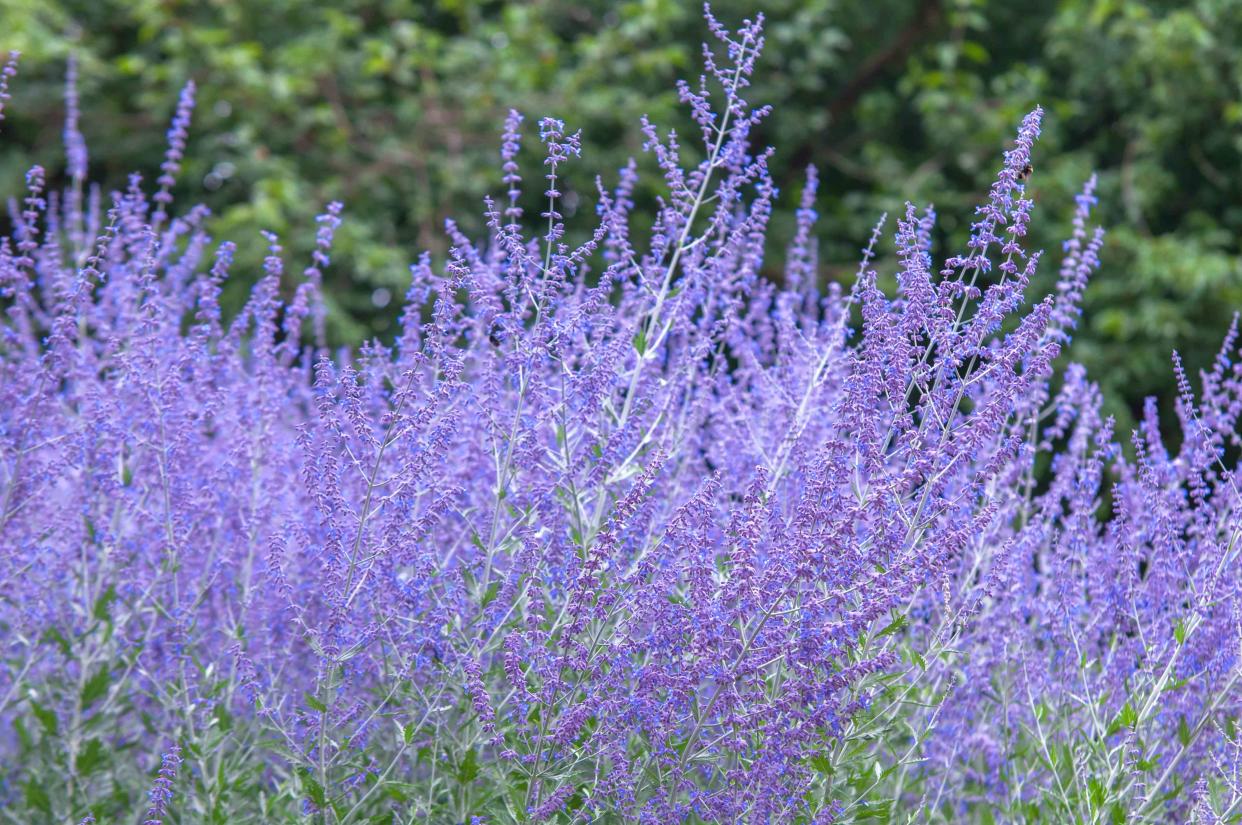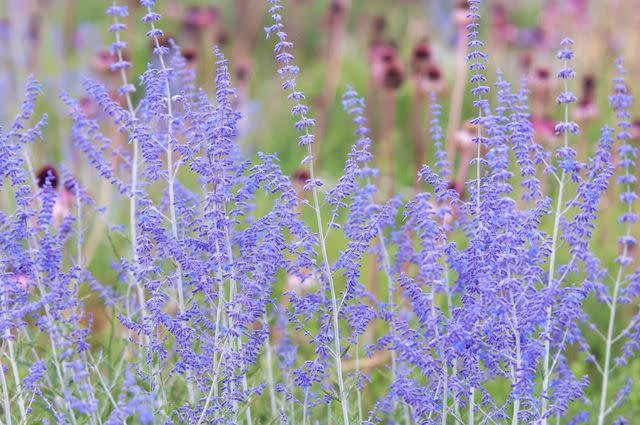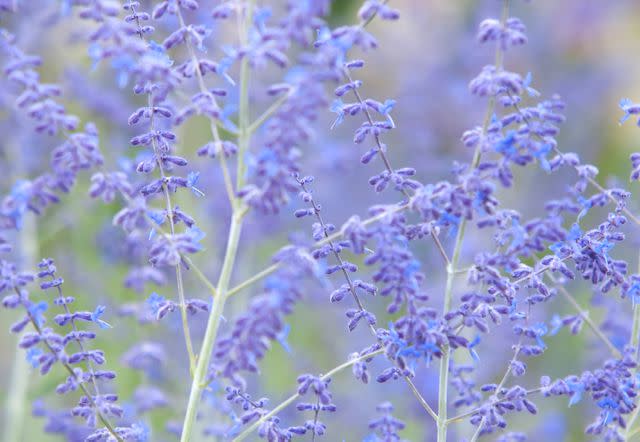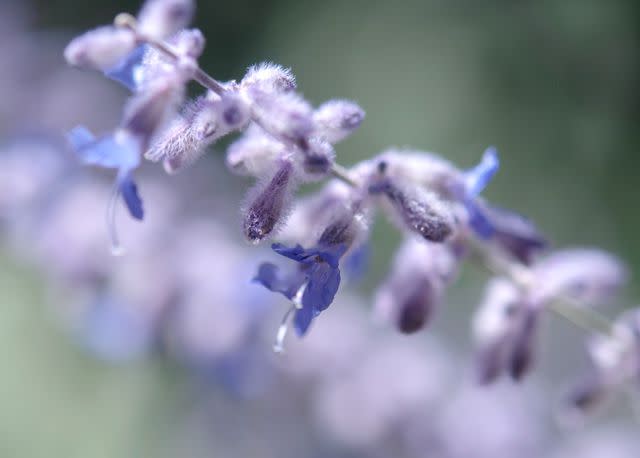Growing Striking Blue Russian Sage Plants Is Easy—Here's How

The Spruce / Evgeniya Vlasova
Russian Sage (Perovskia atriplicifolia) is a drought-tolerant perennial known for its delicate silver-gray foliage and striking lavender-blue blooms. Native to central Asia, this hardy plant thrives in full sun and well-drained soil, making it an ideal choice for dry or rocky landscapes.
If you're looking to add a touch of elegance and charm to your garden, this resilient and picturesque plant might just be the perfect addition.
Common Name | Russian Sage |
Botanical Name | Perovskia atriplicifolia |
Family | Lamiaceae |
Plant Type | Mint |
Mature Size | 4 to 5 ft tall |
Sun Exposure | 6 to 8 hours |
Soil Type | Well-drained soil |
Soil pH | 5.0 to 8.0 |
Hardiness Zones | USDA zones 4-9 |
Native Area | Central Asia |
Toxicity | Non-toxic |
How to Care for the Russian Sage Plant
Here are the main care requirements for growing a Russian sage plant:
Plant Russian sage in full sun and well-drained soil.
Water sparingly, allowing the soil to dry out between waterings.
Apply a layer of mulch around the base of the plant to retain moisture and suppress weeds.
Prune back the previous year's growth in late winter or early spring to encourage new growth.
Monitor for signs of pests and diseases, such as aphids or powdery mildew, and take appropriate measures to address any issues.
Provide support for taller varieties to prevent them from flopping over.
Overwinter by applying a layer of mulch and protecting the plant from frost with a breathable fabric or cold frame.
Want more gardening tips? Sign up for our free gardening newsletter for our best-growing tips, troubleshooting hacks, and more!

The Spruce / Evgeniya Vlasova

The Spruce / Evgeniya Vlasova

The Spruce / Evgeniya Vlasova
Light
Russian sage thrives in full sun, meaning it requires at least six to eight hours of direct sunlight per day to grow and bloom optimally. In areas with intense heat, some afternoon shade may be beneficial to prevent the plant from becoming stressed.
However, in general, providing ample sunlight is essential for the health and vigor of Russian sage plants.
Soil
Russian Sage prefers well-drained soil with a slightly alkaline to neutral pH. It can tolerate a variety of soil types, including sandy, loamy, or clay soils, as long as they are well-draining. Poorly drained or waterlogged soil can lead to root rot and other problems, so it's important to ensure good drainage.
Water
Overall, Russian sage is well-suited to dry conditions and prefers to be slightly dry rather than consistently moist. Once established, it generally requires minimal intervention in terms of watering.
Temperature and Humidity
Russian Sage is well-suited to a wide range of temperature conditions. It is tolerant of both hot summers and cold winters, making it suitable for growing in a variety of climates. However, it is important to note that Russian sage may benefit from some protection in extremely hot or arid climates to prevent stress.
Humid climates, proper air circulation, and spacing between plants can help reduce the risk of fungal diseases such as powdery mildew.
Fertilizer
Fertilize Russian sage sparingly in the spring, just as new growth begins to emerge. Use a balanced, slow-release fertilizer with an NPK ratio of 10-10-10 or similar.
Keep an eye on the growth and health of your Russian Sage after fertilizing. If you notice signs of excessive growth or if the plant becomes leggy, reduce or discontinue fertilization in subsequent years.
Types of Russian Sage Plant
While the classic Russian Sage variety is most common, there are several cultivars available, each offering unique characteristics:
Blue Spire Russian Sage: A compact variety of Russian Sage known for its upright growth habit and abundant lavender-blue flower spikes. It reaches a height of 2 to 3 feet and is perfect for smaller gardens or containers, adding a splash of color and texture to any landscape.
Little Spire Russian Sage: A dwarf cultivar prized for its petite size and bushy, compact form. Standing at just 18 to 24 inches tall, it is ideal for border plantings or rock gardens, where it provides a delicate, airy texture and profusion of lavender-blue blooms throughout the summer months.
Longin Russian Sage: A taller, more robust variety known for its sturdy, upright stems and long-lasting blooms. Reaching heights of up to 4 to 5 feet, it makes a striking focal point in the garden, with its silvery foliage and spikes of violet-blue flowers attracting pollinators and adding vertical interest to the landscape.
Pruning
Pruning plays a crucial role in maintaining the health and appearance of your Russian sage plant. In late winter or early spring, prune back the previous year's growth to encourage vigorous new growth and prevent the plant from becoming leggy.
Additionally, remove any dead or damaged branches throughout the growing season to promote airflow and prevent disease.
Propagating Russian Sage Plant
Gather your pruning shears or a sharp knife, rooting hormone (optional), potting mix (if propagating in soil), small pots or containers, clear plastic bags or plastic wrap (optional).
Choose a healthy, non-flowering stem from the parent plant. Aim for a stem that is about 4-6 inches long, with several sets of leaves.
Using pruning shears or a sharp knife, make a clean cut just below a leaf node (where the leaf meets the stem). Remove any lower leaves to expose a node where roots will form.
(Optional) Dip the cut end of the stem into rooting hormone powder, if desired, to encourage root development. Shake off any excess powder.
If propagating in water: Place the cutting in a glass or jar filled with water, ensuring that at least one or two nodes are submerged. Change the water every few days to prevent stagnation.
If propagating in soil, insert the cut end of the stem into a small pot filled with moist potting mix. Firm the soil gently around the cutting to provide support. Keep the cutting consistently moist, but not waterlogged. Check the soil or water regularly and water as needed to maintain moisture.
Place the cutting in a bright, indirect light location. Avoid direct sunlight, as it can cause the cutting to wilt or dry out.
Once roots have developed and are several inches long, the cutting is ready to be potted into its own container. Carefully transplant the rooted cutting into a larger pot filled with well-draining soil, taking care not to damage the delicate roots.
After transplanting, keep the new plant in a protected location for a few days to allow it to adjust to its new environment. Gradually introduce it to brighter light and normal watering routines.
Roots typically begin to emerge from the cutting within two to four weeks, although this can vary depending on environmental conditions and the health of the cutting. Check the cutting periodically for signs of root growth prior to potting up.
How to Grow Russian Sage Plant from Seed
For those who prefer to start from scratch, growing Russian sage from seed is a viable option.
Begin by sowing the seeds indoors in late winter, as they require a period of cold stratification to germinate successfully. Once the threat of frost has passed, transplant the seedlings outdoors into well-drained soil and watch as they develop into mature plants over the growing season.
Potting and Repotting Russian Sage Plant
While Russian Sage thrives in the ground, it can also be grown successfully in containers, making it a versatile option for gardens of all sizes.
When potting Russian Sage, choose a container with adequate drainage holes and fill it with a well-draining potting mix. As the plant grows, monitor its size and consider repotting into a larger container as needed to accommodate its expanding root system.
Overwintering
In regions with harsh winters, protecting your Russian sage from frost damage is essential for its long-term survival. Before the first frost, apply a thick layer of mulch around the base of the plant to insulate the roots and minimize temperature fluctuations.
Additionally, consider covering the plant with a breathable fabric or installing a temporary cold frame to shield it from extreme cold.
How to Get Russian Sage Plant to Bloom
Achieving a profusion of blooms on your Russian sage plant is a matter of providing optimal growing conditions and proper care. Here’s what you need to know about blooming Russian sage:
Bloom Months
Russian sage typically blooms from mid to late summer, with peak flowering occurring in July and August.
How Long Does Russian Sage Bloom?
Depending on the climate and growing conditions, the flowering period can range from several weeks to several months. In ideal conditions, Russian sage can continue to produce blooms for up to three months or even longer, providing a long-lasting display of its lavender-blue flowers.
What Do Russian Sage’s Flowers Look and Smell Like?
Russian sage produces spikes of small, tubular flowers that are typically a shade of lavender-blue clustered together along tall, slender stems. The fragrance is reminiscent of sage, with hints of mint and lavender, which contributes to the plant's overall appeal.
How to Encourage More Blooms
To encourage more blooms in Russian sage, prune the plant back in late winter or early spring to stimulate new growth, deadhead spent flowers regularly throughout the blooming season, and ensure the plant receives plenty of sunlight and well-drained soil for optimal growth and flowering.
Caring for Russian Sage After It Blooms
After Russian Sage blooms, continue to provide it with ample sunlight and well-drained soil. Consider pruning back spent flower spikes to encourage further blooming and maintain the plant's shape, and monitor for signs of pests or diseases, addressing any issues promptly to keep the plant healthy and thriving.
Deadheading Russian Sage
Deadheading Russian Sage involves the removal of spent flower spikes once they have faded or withered. This simple task not only maintains the plant's neat appearance but also encourages the production of new blooms, prolonging the flowering period and enhancing the overall beauty of the plant.
Common Problems with Russian Sage Plant
While Russian sage is a resilient and low-maintenance plant, it can encounter occasional issues that may affect its health and appearance. Here are several common problems with Russian sage and how you can solve them:
Powdery Mildew
Powdery mildew, a fungal disease that manifests as a white, powdery coating on the foliage. To prevent powdery mildew, ensure proper spacing between plants to promote airflow and avoid overhead watering. If powdery mildew does occur, treat the affected foliage with a fungicidal spray to prevent further spread.
Root Rot
To prevent root rot, plant Russian sage in well-draining soil and water sparingly, allowing the soil to dry out between waterings. If you suspect root rot, carefully dig up the plant and inspect the roots for signs of decay. Trim away any affected roots and replant the healthy portions in fresh soil.
Frequently Asked Questions
Does Russian Sage come back annually?
Yes, Russian Sage typically comes back annually as a perennial.
Does Russian Sage attract pollinators?
Yes, Russian Sage flowers attract pollinators such as bees and butterflies.
Is Russian Sage invasive?
Russian Sage is not considered invasive in most regions but can spread if not managed.
Read the original article on The Spruce.

